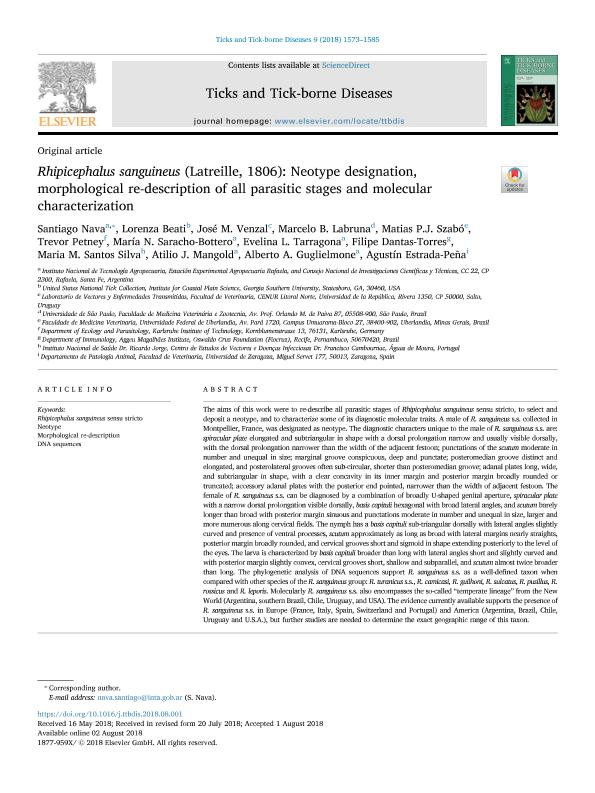Artículo
Rhipicephalus sanguineus (Latreille, 1806): Neotype designation, morphological re-description of all parasitic stages and molecular characterization
Nava, Santiago ; Beati, Lorenza; Venzal, José M.; Labruna, Marcelo B.; Szabó, Matias P.J.; Petney, Trevor; Saracho Bottero, María Noelia
; Beati, Lorenza; Venzal, José M.; Labruna, Marcelo B.; Szabó, Matias P.J.; Petney, Trevor; Saracho Bottero, María Noelia ; Tarragona, Evelina Luisa
; Tarragona, Evelina Luisa ; Dantas Torres, Filipe; Santos Silva, Maria Margarida; Mangold, Atilio Jose
; Dantas Torres, Filipe; Santos Silva, Maria Margarida; Mangold, Atilio Jose ; Guglielmone, Alberto Alejandro
; Guglielmone, Alberto Alejandro ; Estrada Peña, Agustín
; Estrada Peña, Agustín
 ; Beati, Lorenza; Venzal, José M.; Labruna, Marcelo B.; Szabó, Matias P.J.; Petney, Trevor; Saracho Bottero, María Noelia
; Beati, Lorenza; Venzal, José M.; Labruna, Marcelo B.; Szabó, Matias P.J.; Petney, Trevor; Saracho Bottero, María Noelia ; Tarragona, Evelina Luisa
; Tarragona, Evelina Luisa ; Dantas Torres, Filipe; Santos Silva, Maria Margarida; Mangold, Atilio Jose
; Dantas Torres, Filipe; Santos Silva, Maria Margarida; Mangold, Atilio Jose ; Guglielmone, Alberto Alejandro
; Guglielmone, Alberto Alejandro ; Estrada Peña, Agustín
; Estrada Peña, Agustín
Fecha de publicación:
09/2018
Editorial:
Elsevier GmbH
Revista:
Ticks and Tick-borne Diseases
ISSN:
1877-959X
e-ISSN:
1877-9603
Idioma:
Inglés
Tipo de recurso:
Artículo publicado
Clasificación temática:
Resumen
The aims of this work were to re-describe all parasitic stages of Rhipicephalus sanguineus sensu stricto, to select and deposit a neotype, and to characterize some of its diagnostic molecular traits. A male of R. sanguineus s.s. collected in Montpellier, France, was designated as neotype. The diagnostic characters unique to the male of R. sanguineus s.s. are: spiracular plate elongated and subtriangular in shape with a dorsal prolongation narrow and usually visible dorsally, with the dorsal prolongation narrower than the width of the adjacent festoon; punctations of the scutum moderate in number and unequal in size; marginal groove conspicuous, deep and punctate; posteromedian groove distinct and elongated, and posterolateral grooves often sub-circular, shorter than posteromedian groove; adanal plates long, wide, and subtriangular in shape, with a clear concavity in its inner margin and posterior margin broadly rounded or truncated; accessory adanal plates with the posterior end pointed, narrower than the width of adjacent festoon. The female of R. sanguineus s.s. can be diagnosed by a combination of broadly U-shaped genital aperture, spiracular plate with a narrow dorsal prolongation visible dorsally, basis capituli hexagonal with broad lateral angles, and scutum barely longer than broad with posterior margin sinuous and punctations moderate in number and unequal in size, larger and more numerous along cervical fields. The nymph has a basis capituli sub-triangular dorsally with lateral angles slightly curved and presence of ventral processes, scutum approximately as long as broad with lateral margins nearly straights, posterior margin broadly rounded, and cervical grooves short and sigmoid in shape extending posteriorly to the level of the eyes. The larva is characterized by basis capituli broader than long with lateral angles short and slightly curved and with posterior margin slightly convex, cervical grooves short, shallow and subparallel, and scutum almost twice broader than long. The phylogenetic analysis of DNA sequences support R. sanguineus s.s. as a well-defined taxon when compared with other species of the R. sanguineus group: R. turanicus s.s., R. camicasi, R. guilhoni, R. sulcatus, R. pusillus, R. rossicus and R. leporis. Molecularly R. sanguineus s.s. also encompasses the so-called “temperate lineage” from the New World (Argentina, southern Brazil, Chile, Uruguay, and USA). The evidence currently available supports the presence of R. sanguineus s.s. in Europe (France, Italy, Spain, Switzerland and Portugal) and America (Argentina, Brazil, Chile, Uruguay and U.S.A.), but further studies are needed to determine the exact geographic range of this taxon.
Archivos asociados
Licencia
Identificadores
Colecciones
Articulos(CCT - SANTA FE)
Articulos de CTRO.CIENTIFICO TECNOL.CONICET - SANTA FE
Articulos de CTRO.CIENTIFICO TECNOL.CONICET - SANTA FE
Citación
Nava, Santiago; Beati, Lorenza; Venzal, José M.; Labruna, Marcelo B.; Szabó, Matias P.J.; et al.; Rhipicephalus sanguineus (Latreille, 1806): Neotype designation, morphological re-description of all parasitic stages and molecular characterization; Elsevier GmbH; Ticks and Tick-borne Diseases; 9; 6; 9-2018; 1573-1585
Compartir
Altmétricas



